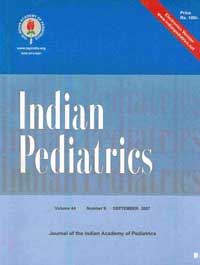 |
|
|
K Rajeshwari,
Email:
[email protected]
|
 |
Universal pneumoccocal vaccination (MMWR Morb
Mortal Wkly Rep 2008 Oct 24; 57(42):1148-51) |
|
This report summarizes the progress made in introducing
pneumococcal conjugate vaccine (PCV) that includes seven pneumococcal
serotypes, worldwide. The World Health Organization (WHO) and UNICEF have
recognized the safety and effectiveness of PCV and recommend these
vaccines to be included in national immunization programs. As of August
2008, 26 countries offered PCV7 to all children as part of national
immunization programs or had PCV7 in widespread use (i.e., with estimated
national coverage >50%); however, none of these countries is a low-income
or lower-middle income country.
Comment As pneumonia
is a major cause of under five mortality it will be prudent to introduce
pneumococcal vaccine in our national immunization schedule. However
vaccine cost may be a major prohibitive factor. |
 |
Differentiating fractures due to child abuse (BMJ
2008; 337:a1518) |
|
Skeletal fractures are diagnosed in up to one-third of
children investigated for physical abuse. The fractures are often occult
and they occur in infants and toddlers who cannot give a causal
explanation. This study systematically reviewed published studies to
identify the characteristics that distinguish between fractures resulting
from abuse and those from other reasons. Fractures resulting from abuse
were most common in infants and toddlers (0-3 yr), multiple, and commonly
involved ribs; supracondylar humeral fractures were less likely to be
inflicted. However, studies were insufficient to allow calculation of a
probability of abuse for all types of fractures.
Comment No fracture,
on its own, can distinguish an abusive from a non-abusive cause. Age of
the child and the site and type of fracture can help determine the
likelihood of abuse. |
 |
Prenatal acetaminophen exposure and respiratory
symptoms in first year of life (Ann Allergy Asthma Immunol 2008;
101(3):271-8) |
|
This study examined the relationship between in
utero exposure to acetaminophen and incidence of respiratory symptoms
in the first year of life. A total of 345 women were recruited in the
first trimester of pregnancy and followed up with their children through
the first year of life. Use of acetaminophen in middle to late pregnancy
was significantly related to wheezing (odds ratio, 1.8; 95% confidence
interval, 1.1-3.0) and to wheezing that disturbed sleep (odds ratio, 2.1;
95% confidence interval, 1.1-3.8) in the first year of life after control
for potential confounders.
Comment Additional
follow-up studies are required to determine whether maternal use of
acetaminophen actually leads to increased incidence of asthma at 3 to 5
years. |
 |
Home heating reduces symptoms of asthma (BMJ
2008; 337: 1411) |
|
This randomized controlled trial from New Zealand
conducted on 409 children aged 6-12 years assessed whether non-polluting,
effective home heating has a
positive effect on the health of children with doctor diagnosed asthma.
The study group received a non-polluting home heater before winter.
Improvements in lung function (peak expiratory flow rate and forced
expiratory volume in one second, FEV1) were not significant. Compared with
children in the control group, however, children in the intervention group
had fewer days off school, fewer visits to a doctor for asthma, less sleep
disturbed by wheezing, and less dry cough at night.
Comment The time tested method of staying in warm indoors during
winter may prove to be helpful for children with asthma. |

